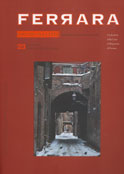"I appoint the foundation as constituted above", continues the will of Giuseppe Pianori, "as my sole heir, and my estate will constitute its initial assets. This includes the funerary arch of the Pianori family in Certosa, which is of recognised artistic value".
At this point, it is worth emphasising the fact that by creating the eponymous Foundation - which has been recognised as a legal entity since 1981 - in his will, Giuseppe Pianori has endowed the city of Ferrara with a significant point of reference in such an important field as the art world.
Nobody can dispute the civic value of such an act, through which private capital funds the public administration to achieve a noble end: recovering an intellectual heritage which has been dispersed across the art market.
More significant is Pianori's choice of the pro tem president of the Cassa di Risparmio savings bank as president of the Foundation: the city's most important credit institute, in terms of both its history and its size, has been appointed to represent the new institution on the legal front.
The will achieved this end through the creation of the Fondazione Cassa di Risparmio di Ferrara - under Law 318/90, better known as the "Amato law" - which is recognised as a transferring company as well as a "historical continuation" of the Cassa di Risparmio di Ferrara.
The Civic Gallery of Modern and Contemporary Art in Palazzo Massari - directed by Franco Farina and Andrea Buzzoni - has seen a significant increase in the artistic heritage which it preserves, coupled with ongoing growth in visitor numbers.
Thanks to the testator and to careful management of the available financial resources, the Gallery has received twenty or so works by Filippo De Pisis since 1982, along with three paintings by the nineteenth-century vedutista (painter of views) Giuseppe Chittò-Barucchi and significant core elements of the Bianchi-Zajna collection, which brings together the best of nineteenth- and twentieth-century Ferrarese art.
The list is long, but it is worth at least running through it alphabetically, to give some indication of the scope of the coverage and the seriousness of the commitment: Bernagozzi, Casarotti, M. Chailly, Crispini, De Vincenzi, Droghetti, Ferrari, Laurenti, Legnani, Longanesi, Mantovani, Mentessi, Milani, Nenci, Pisa, Previati, Ravegnani, Tagliaferri, Ughi, Zaffarini.
The most recent purchase, which was made a few months ago, was intended to fill in a "serious gap" - to quote Andrea Buzzoni - in the Gallery's "De Pisis in Ferrara" collection: it did not have a work which appropriately represented the artist's work over the two years 1927-28, when he was focusing on "metaphysical marine still lifes".
Now it has Les oignons de Socrates, a work from 1927, which had always been in the private collection of the writer André Pieyre de Mandiargues, who was not only a friend and critic of De Pisis, but also the husband of his niece Bona.
It was shown in Ferrara in 1996 as part of the celebratory exhibition for the first centenary of the artist's birth and has now returned to the city, the cradle of Metaphysical art and the birthplace of its creator.
It is now back for good, alongside another extraordinary De Pisis, I grandi fiori di Casa Massimo, which dates from 1931 and has been purchased by the Fondazione Cassa di Risparmio di Ferrara.



